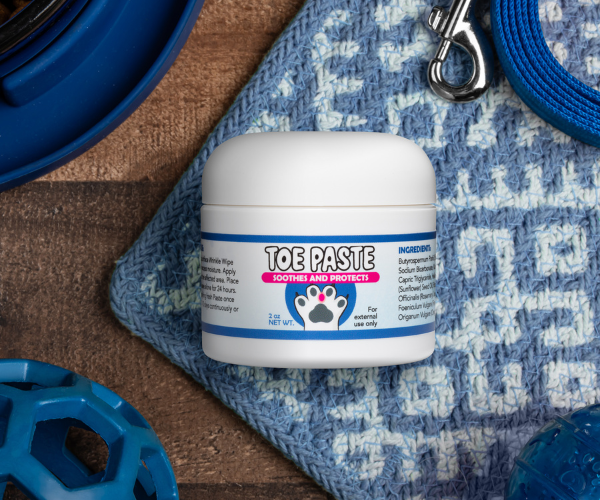How to Avoid Chemical Treatments on Your Dogs Skin

Curious about chemicals on your dogs skin? We all know our dogs love rolling around on the ground or being a mucky pup chasing after squirrels in the park. You can see the enjoyment in the big squishy faces. As they jump about your feet, their tongues lolling out their mouths, and their eyes begging you for one last game of fetch.
It’s why we love them so much!
But many owners assume that because their dogs spend their days lounging on the ground or chewing sticks and toys that they’re impervious to everything. They imagine their dogs have stomachs of steel and skin of iron. Nothing affects them.
Not so.
It’s not the mud and the dust that bothers our pooches, but the chemicals from products on your dogs skin. We’re all devoted to our four-legged friends. We meticulously clean their wrinkles and folds, wipe away their tear stains, and soothe the irritated skin in their tail pockets. But all too often, the products we use can do more harm than good.
Man might be a dog’s best friend, but man-made chemicals certainly aren’t!
Chemical Treatments are Too Harsh for Your Dogs Skin
Too many new dog products are chock-full of chemicals. These can cause several different health problems, despite the claims on the packaging.
First of all, your dog might be allergic. Soon enough that nasty, sore rash you were trying to soothe is even more irritated. The more chemicals in the product, the more likely your dog is in for a nasty surprise. Nor are allergic reactions a simple matter. They can be extremely severe, in some cases even threatening a dog’s life.
Meanwhile, there is a whole range of other unpronounceable chemicals lurking in the ingredient’s sections of many popular products. Formaldehyde preservatives can cause burning, itching and blistering of your dog’s skin. At the same time, isothiazolinone preservatives are known skin irritants with a history of causing allergic reactions.
As a handy rule, remember: if you can’t pronounce it, avoid it.
Even more concerning are the carcinogenic effects of artificial colors. Dog foods are the most common source of artificial coloring. Still, they can also be found in other dog products, like shampoos and other treatments. Products that go directly on your dogs skin! Often, these chemicals can be linked to allergic reactions and even infections!
Artificial Fragrances Overwhelm Your Dog’s Senses and Can be Harsh on Your Dogs Skin
We all love the amazing smell of our dog’s when they come home from the groomer or the rich fragrance from your favorite doggy treatment. I mean, how could something that smells so good, be bad?
Sadly, your dog probably doesn’t agree.
Your dog’s sense of smell is a lot stronger than yours – they have an incredible 300 million receptors in their nose, compared to your measly 6 million. So, a waft of a succulent aroma to you is an overpowering and eye-watering stench to them.
Fragrances are even more deceiving. While it seems like it is just one scent, in reality, hundreds of chemicals make up the aroma. Nor do manufacturers always have to tell you what’s in there. These chemicals have been associated with neurological problems and can impair your dog’s immune system.
Worryingly, these fragrances are in all sorts of chemical treatments, from shampoos to creams.
Always Read the Label
Keeping track of the endless list of chemicals is a full day’s work. Every label needs to be read and analysed, as you become a detective, a sleuth, a chemical Sherlock Holmes hunting through the mysterious ingredients. Words such as ‘fragrance’ or ‘parfum’ are a clue; being used as a euphemism for artificial fragrances. But they’re not the only chemicals at work. Some products are labelled deceptively, for example, ‘nature identical’ in chemical-speak means synthetic, in the same way, that a plastic plant is ‘identical’ to a geranium
However, even some natural scents can be harmful, particularly essential oils. The worst offenders include tea-tree oil (particularly bad for cats), cinnamon, pennyroyal, pine, sweet birch, and wintergreen. Most oils are completely safe for your dog to use, but when using commercial products from big companies, it pays to do your research.
Or, you can save yourself the hassle and go with a treatment you trust, with a brand that cares.
At Squishface, Our Products are Gentle and Kind to Your Dogs Skin
Faced with the chemical-laden treatments on the market, we set out to create our dream product. A hypoallergenic paste that uses plant-based ingredients like coconut oil (one of the best oils for skin) to keep our dog’s beautiful squishy faces sparkling clean.
Some of our favorite breeds, such as English Bulldogs, Frenchies, Pugs, Maltese, Pomeranians and Poodles, are susceptible to tear stains near their eyes. Debris and other gunk cause tear stains by blocking the tear ducts of your dog’s eyes, sometimes leading to a nasty infection.
But we didn’t want to apply chemical treatments in such a sensitive area. That’s how Squishface Wrinkle Paste was born.
The Paste isn’t just a natural treatment for your dog’s tear stains; wrinkles, folds and tail pockets will also benefit. The natural plant-based formula works as a water-repellent barrier, reducing moisture, fungus and bacteria and thus protecting against fungi and bacteria.
There’s no longer any need to scour labels for red-flag chemicals or let your dog suffer in silence.
Apply our fast-acting paste, and your dog will be clean and fresh. It works on our squishy-faced friends like Bulldogs, as well as long-haired breeds such as poodles.
For more tips, tricks, and favorite products, roll over to the Squishface Blog. Don’t forget to check back in every week for even more canine content!











